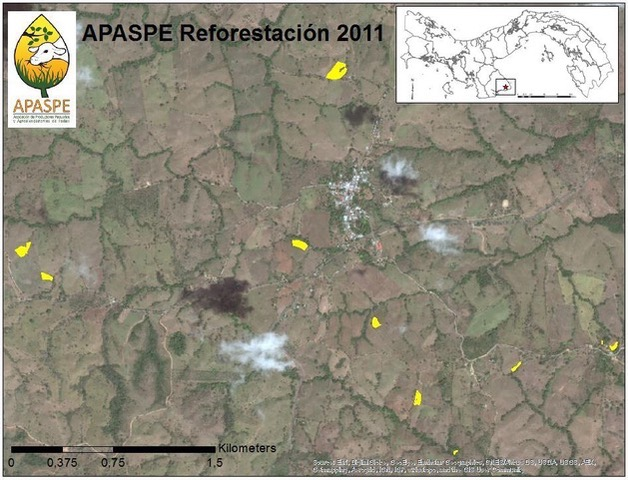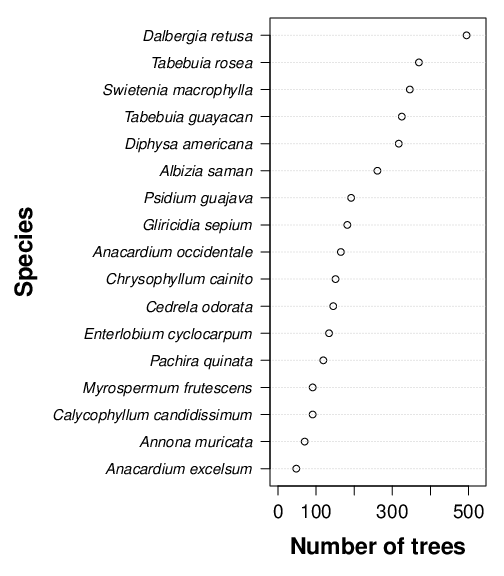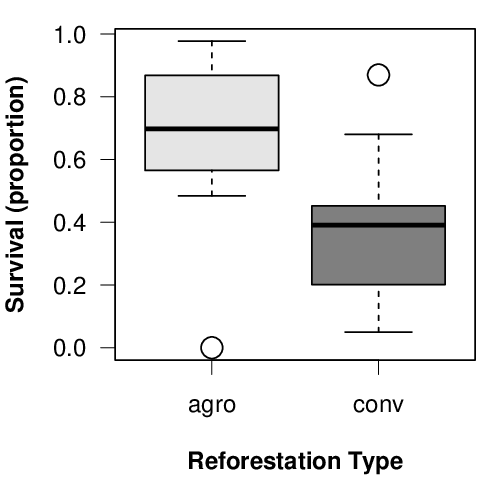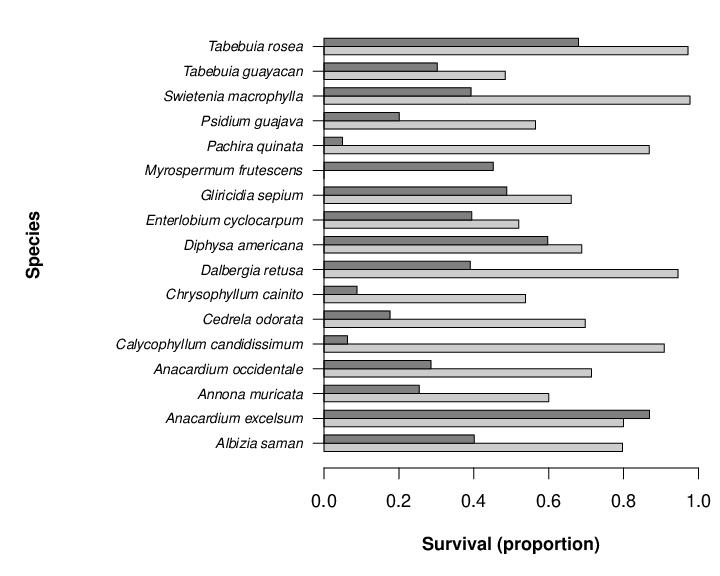Establishment success of 19 native tropical dry forest tree species under reforested cattle ranching landscapes in the Azuero Peninsula, Panama
Establishment success of 19 native tropical dry forest tree species under reforested cattle ranching landscapes in the Azuero Peninsula, Panama
Veronica Chang, MEM1
Abstract
Comprehensive evaluation of reforestation success can assist reforestation project planning and support rural communities in developing countries to alleviate poverty and improve their quality of life. The Azuero Peninsula is one of the most endangered and severely deforested territories of Panama. Anthropogenic drivers have exposed this tropical dry forest region to continuous degradation and loss of biodiversity and ecosystem services. Conventional cattle ranching practices have dominated this region, decreasing on-farm productivity. The Association of Livestock and Agro-Silvopastoral Producers of Pedasi (APASPE) has become a leader in implementing sustainable cattle ranching and forest restoration projects. The objective of this study was to evaluate the success of tropical dry forest reforestation with 19 native species, after 4 years of plantation through survival, growth, crown area, and biomass. Results of this study showed that agroforestry plantations performed better than conventional plantings. Mean survival was 33.25% greater in agroforestry than conventional plots. Anacardium excelsum showed high survival rates among plots, followed by Tabebuia rosae and Swietenia macrophylla. These findings illustrate the performance of native species in timber plantations and agroforestry systems, allowing for initial site-specific recommendations of potentially valuable species for restoration and other uses.
La evaluación completa del éxito de una reforestación puede favorecer la planificación de proyectos de reforestación y ayudar a las comunidades rurales de los países en desarrollo en la lucha por aliviar la pobreza y mejorar su calidad de vida. La Península de Azuero es uno de los territorios más amenazados y severamente deforestados de Panamá. Factores antropogénicos han expuesto a esta región de bosque seco tropical a la continua degradación y pérdida de la biodiversidad y servicios ambientales. Las prácticas convencionales de ganadería han dominado a esta región por décadas, disminuyendo la productividad de las fincas agropecuarias. La Asociación de Productores Pecuario y Agro-silvopastoriles de Pedasí (APASPE) se ha convertido en líder en la implementación de proyectos de restauración forestal y ganadería sostenibles. El objetivo de este estudio fue evaluar el éxito de la reforestación de bosque seco tropical con 19 especies nativas, después de 4 años de plantación, a través del índice de supervivencia de las especies forestales. Los resultados de este estudio mostraron que, las plantaciones agroforestales obtuvieron mejores resultados que las plantaciones convencionales. La supervivencia media fue 33,25% mayor en las parcelas agroforestales que en las convencionales. Anacardium excelsum mostró altas tasas de supervivencia promedio entre todas las parcelas, seguida de Pachira quinata y Tabebuia rosea . Estos hallazgos ilustran el desempeño de especies nativas en plantaciones forestales convencionales y sistemas agroforestales, permitiendo dar recomendaciones iniciales específicas al sitio acerca de especies potencialmente valiosas para la restauración y otros usos.
Introduction
Dry forests in Latin America have experienced a 12% loss of habitat and forested area between 1980 and 2000 (Miles et al., 2006), becoming one of the most endangered ecosystems in the Neotropics, with only 1.7% of the original cover remaining in Central America (Calvo-Alvarado, McLennan, Sanchez-Azofeifa, & Garvin, 2009). Anthropogenic disturbances, such as deforestation and use of fire to convert forest to agriculture or pasture systems have exposed this biome to continuous degradation with the resulting loss of unique biodiversity and weakening of ecosystem service integrity. Panama’s Azuero Peninsula, which comprises predominantly of tropical dry forests, has a long history of cultivation, cattle ranching, and urban expansion. The Azuero Peninsula is also one of the most endangered and severely deforested territories of Panama (Metzel & Montagnini, 2014). The most prevalent land-use in Azuero is conventional cattle pastures. Within the Province of Los Santos, where this study took place, 62% of land area is in pasture (Trejos Castillo, 2004). Conventional pastures entail removing and burning forests, applying herbicides and planting exotic pasture grasses, which are often overgrazed, decreasing on-farm productivity. Among other pathways, degraded cattle pastures may be abandoned, or rehabilitated to support diversity and quality and quantity of ecosystem services (Griscom, Ashton, & Berlyn, 2005).
In Mesoamerica, environmental, economic and livelihood benefits offered by trees have increased the interest of small landholders in utilizing a diversity of native species for restoration purposes (Garen et al., 2011; Garen et al., 2009; Montagnini, Gonzalez, Porras, & Rheingans, 1995). Recent work in Panama has assessed survival and initial growth of native tree species optimal growth over a broad precipitation and soil fertility gradients (Hall et al., 2011; Van Breugel et al., 2011; Wishnie et al., 2007). However, information is lacking on the potential for reforestation under regimes that are more influenced by humans in such heavily agricultural landscape, for example on abandoned cattle pastures.
The Environmental Leadership & Training Initiative (ELTI), an initiative of Yale University’s School of Forestry and Environmental Studies (F&ES) in collaboration with the Smithsonian Tropical Research Institute (STRI), seeks to empower people to enhance biodiversity, ecosystem services and livelihoods in tropical forest landscapes by developing local capacity to protect and restore native tree and forest in agricultural landscapes. The Association of Livestock and Agro-Silvopastoral Producers of Pedasi (APASPE), a group of landowners that participate in ELTI’s Training and Leadership Programs in Azuero, is comprised of approximately 38 landholders who have become leaders in implementing sustainable cattle ranching practices and forest restoration. APASPE members have implemented two large forest restoration and sustainable ranching projects funded by the Global Environment Facility’s (GEF) Small Grants Programme (SGP) that focus on recuperating riparian forests, native species reforestation and silvopastoral systems (SPS).
To assess reforestation success, based on the physical and socio-economic objectives of reforestation projects, performance measures should be evaluated during the main stages of the restoration (Le, Smith, Herbohn, & Harrison, 2012). The evaluation of performance of the APASPE on-farm reforestation plantings in riparian areas is important in terms of illustrating the success or failure of native species when established in cattle ranching landscapes. This can be challenging due to the variety of biophysical and social variables that can affect successful tree establishment. Comparing tree growth with different management strategies (conventional plantation versus agroforestry systems) is also relevant for helping farmers design methods to potentially improve performance and decrease cost, which are incentives that are increasingly important due to the high costs and lack of incentive policies for forest restoration.
In this paper, we evaluate the establishment success of tropical dry forest riparian reforestation with 19 native species after 4 years of plantation (Le et al., 2012), following survival from 2011 to 2016. In particular, I asked the following questions:
-
Do trees differ in establishment success in agroforestry versus conventional reforestation systems?
-
Do species differ in their overall establishment success?
-
Do species differ in establishment success between agroforestry versus conventional systems?
Results from these studies will illustrate the performance of native species and potential economic benefits from timber species plantations and agroforestry systems. Additionally, the results will be utilized to develop a restoration strategy case study and other training materials for local stakeholders.
Methods
Study site
The study was conducted in the town of Los Asientos (Fig. 1) in the province of Los Santos, Panama (7°31’N, 80°8’W). Los Asientos is a small rural town with a population of approximately 755 people. The landscape around Los Asientos is constituted mostly of agricultural and cattle ranching lands with fragments of secondary tropical dry forest rich in biodiversity. The climate of Los Santos is tropical savanna (Koppen classification) presenting two predominant seasons (wet and dry) with temperatures oscillating from 28˚C and average precipitation of approximately 1100 mm per year. According the Holdridge classification, the area of Los Asientos belong to the life zone of Tropical Dry Forest (INEC, n.d.).

Reforestation plots
In 2011, as part of their first-phase sustainable ranching and riparian restoration project, APASPE established 12 mixed species reforestation plots (with ranges of 0.1 and 1.2 hectares) that consist of a total of 3691 individuals, including 3590 native fruit and timber species, covering approximately a total of 3.07 hectares (Fig.1). Although all plots are located in the same region and near the population of Los Asientos, they differ in aspects of area of reforestation, landform (lower, mid and upper slope), land use (conventional and agroforestry plantation), distance to riparian zone (from 140 to 1140 m), and disturbances to the site (grazing animals, insects and drought).
The following native tree species were available to plant by landholders, from which they voluntarily selected the preferable species to be planted, Albizia saman, Anacardium excelsum, Anacardium occidentale, Annona muricata, Calycophyllum candidissimum, Cedrela odorata, Chrysophyllum cainito, Cordia alliodora, Dalbergia retusa, Diphysa americana, Enterlobium cyclocarpum, Gliricidia sepium, Inga spp, Myrospermum frutescens, Pachira quinata, Psidium guajava, Swietenia macrophylla, Tabebuia guayacan and Tabebuia rosea.
The plantation spacing for all the sites (conventional and agroforestry plantations) was 3 x 3 m, as it is considered the most appropriate for optimal growth for tropical tree species (Grant, Nichols, Pelletier, Glencross, & Bell, 2006). In four of the 12 plots, farmers utilized agroforestry planting techniques following a Taungya system in which, annual, perennial, and forage crops were planted among forest plantations during the first years after establishment, with the purpose of use the available space and provide food and income to the landowners and their families who own these farms (Escalante 2015). These crops included pigeon pea, cassava, maize, beans, plantains, and Mexican sunflower. The other eight plantations were established without any type of intercropping. All trees were planted in riparian areas (with average distance to the riparian zone of 0.32 km) in order to provide a large buffer zone for important watershed areas.
Baseline information was recorded for each plot on the number of individuals by species. ELTI’s Panama Coordinator, Jacob L. Slusser measured all plots for the first time in June 2015. Sapling survival (1756 native tree seedlings) was tallied and basal diameter (50mm above ground level) was recorded for all species. To assess reforestation success, in 2016 we measured various indicators of establishment success (survival rate of trees), growth success (tree growth), vegetation structure (crown area), and biomass (Le et al. 2012). In particular, for this study we examined the survival of planted trees from 2011 to 2016.
Data analysis
Two species (Cordia alliodora and Inga spp.) were removed from this analysis, since both were initially established only in conventional plots.
To compare tree survival in conventional versus agroforestry plots (Q1), I evaluated the number of dead and alive trees in 2016 with a proportion test. To compare survival rates among species (Q2), I applied a χ2 test, comparing the proportion of alive trees of each species. To compare survival rates of species in conventional versus agroforestry systems (Q3), I utilized a generalized linear model (GLM) to test the effect of species and plantation systems on the proportion of alive trees in 2016. All analyses were performed using R Studio (Version 1.0.136).
Results
In the 12 APASPE restoration plots in 2016, we identified 1,756 individuals (not including non-native species and individuals that were naturally regenerated or replanted), representing 19 native tree species, 17 genera, and 11 families. The most common species were Tabebuia rosea, Dalbergia retusa and Swietenia macrophylla, comprising 46% of all individuals (16.7%, 15.7%, and 13.7%, respectively; Fig. 2).

Survival of trees in conventional vs. agroforestry systems
A total of 3,590 native trees were planted in 2011: 2,582 in conventional and 1,008 in agroforestry plots. Of these, a total of 1,756 survived to 2016: 945 in conventional plots and 811 in agroforestry plots. Overall survival was greater in agroforestry plots (2-sample test for equality of proportions: χ2 = 566.71, df = 1, P < 0.001).
At the plot level, survival varied from 22% to 89%. Mean survival rate in the eight conventional plots was 35.8 ± 22.2% (range = 4.9–87.0%), whereas mean survival rate in the four agroforestry plots was 69.1 ± 24.1% (0.0–97.8%). (Fig. 3).

Survival rates of species
Overall mean survival of species was 52.4 ± 16.9% (range = 0% Myrospermum frutescens in agroforestry sites to 97.8% Swietenia macrophylla in agroforestry sites) and varied significantly among species (χ2 = 469.89, df = 16, p < 0.0001, Fig. 4). The species with the highest overall survival were Anacardium excelsum, Tabebuia rosae and Swietenia macrophylla, while the species with the lowest average survival rate was Myrospermum frutescens (Fig. 4).

Survival rates of species and reforestation system
Over all species, survival in conventional plantations was significantly lower than in agroforestry plantations (GLM, z = -21.49, p < 0.0001).
Differences in survival rates between agroforestry and conventional systems ranged from -0.85 to 0.45 (mean = -0.33). The species with the biggest difference were Calycophyllum candidissimum, Pachira quinata, Swietenia macrophylla, and Dalbergia retusa, with higher survival in agroforestry. However, all but two species (Anacardium excelsum and Myrospermum frutescens) had higher survival under the agroforestry system, and there was a significant interaction between species and reforestation system (χ2 test: deviance = 190.42, p < 0.0001, Fig. 4).
Conclusion
The tropical dry forest in the Azuero peninsula has supported the local rural communities for their livelihoods and ecosystem services for centuries. However, conventional cattle ranching has dominated this region for decades, degrading the land and decreasing farm productivity. The performance of the APASPE on-farm reforestation plantings in riparian areas is important in terms of recuperating the ecosystem services of the dry forest. By using short-term establishment indicators, we can illustrate the success or failure of the plantations under agroforestry and conventional systems, allowing to make initial site-specific recommendations of potentially valuable species for restoration and other uses.
In this study, we analyzed data across on-farm reforestation plots in Los Asientos, Panama to evaluate restoration success of forest communities under agroforestry and conventional restoration models. Our study used 12 sites. We measured and quantified restoration success through the use of potential indicators and analyzed the differences in survival between sites that share similar production schemes. Variability in these indicators has been observed among plots, where trees planted under agroforestry systems showed a greater survival rate than tress in conventional plantings, suggesting distinctions in farm management and/or specific conditions at each site. Mean survival rate was 33.25% greater in agroforestry than conventional plots. Overall Anacardium excelsum exhibited high average survival rate (83.48%) with low variability for both conventional and agroforestry sites, and showed the greatest survivorship among species at conventional plantations. On the other hand, survivorship of Calycophyllum candidissimum and Pachira quinata was markedly higher (above 80%) in the agroforestry as compared to the conventional plots (Fig. 4).
This information could consequently help in setting long-term goals for future restoration project planning, as diverse native timber and fruit species can be established in hostile ranching landscapes with more success via agroforestry systems, as the data illustrates, which is an important restoration strategy for these types of productive landscapes.
Acknowledgements
I’m extremely grateful to my research advisor Florencia Montagnini, to ELTI Panama staff for their logistical and technical support during this project, to the farmers of Los Asientos for their unconditional help and advice, and to my colleagues and fieldwork team: Jonas Lechner, Asha Bertsch, and Jorge Gutierrez. This study received financial support from the Yale Tropical Resources Institute Fellowship and the Armbrecht Fund at Yale University.
References
Calvo-Alvarado, J., McLennan, B., Sanchez-Azofeifa, A., & Garvin, T. 2009. Deforestation and forest restoration in Guanacaste, Costa Rica: Putting conservation policies in context. Forest Ecology and Management 258, 931–940. doi: 10.1016/j.foreco.2008.10.035.
Garen, E.J., Saltonstall, K., Ashton, M.S., Slusser, J.L., Mathias, S., & Hall, J.S. 2011. The tree planting and protecting culture of cattle ranchers and small-scale agriculturalists in rural Panama: Opportunities for reforestation and land restoration. Forest Ecology and Management 261, 1684–1695. doi: 10.1016/j.foreco.2010.10.011.
Escalante, E. E., & Guerra, Á. 2015. Sistemas taungya en plantaciones de especies forestales de alto valor comercial en Venezuela. In: Montagnini, F., Somarriba, E., Murgueitio, E., Fassola, H., & Eibl, B. Sistemas Agroforestales: Funciones productivas, socioeconómicas y ambientales. Serie técnica. Informe técnico 402. CATIE, Turrialba, Costa Rica. Editorial CIPAV, Cali, Colombia. pp 45–58.
Garen, E.J., Saltonstall, K., Slusser, J.L., Mathias, S., Ashton, M.S., & Hall, J.S. 2009. An evaluation of farmers’ experiences planting native trees in rural Panama: Implications for reforestation with native species in agricultural landscapes. Agroforestry Systems 76, 219–236. doi: 10.1007/s10457-009-9203-4.
Grant, J. C., Nichols, J.D., Pelletier, M.C., Glencross, K., & Bell, R. 2006. Five year results from a mixed-species spacing trial with six subtropical rainforest tree species. Forest Ecology and Management 233, 309–314. doi: 10.1016/j.foreco.2006.05.027.
Griscom, H.P., Ashton, P.M.S., & Berlyn, G.P. 2005. Seedling survival and growth of native tree species in pastures: Implications for dry tropical forest rehabilitation in central Panama. Forest Ecology and Management 218, 306–318. doi: 10.1016/j.foreco.2005.08.026.
Hall, J.S., Love, B.E., Garen, E.J., Slusser, J.L., Saltonstall, K., Mathias, S., & Spaner, D. 2011. Tree plantations on farms: Evaluating growth and potential for success. Forest Ecology and Management 261, 1675–1683.
INEC, I.N.d.E.y.C.P. (n.d.). from https://www.contraloria.gob.pa/inec/Default.aspx
Le, H.D., Smith, C., Herbohn, J., & Harrison, S. 2012. More than just trees: Assessing reforestation success in tropical developing countries. Journal of Rural Studies 28, 5–19. doi: 10.1016/j.jrurstud.2011.07.006.
Metzel, R., & Montagnini, F. 2014. From farm to forest: Factors associated with protecting and planting trees in a Panamanian agricultural landscape. Bois Et Forets Des Tropiques 322, 3–15.
Miles, L., Newton, A.C., DeFries, R.S., Ravilious, C., May, I., Blyth, S., & Gordon, J.E. 2006. A global overview of the conservation status of tropical dry forests. Journal of Biogeography 33, 491–505. doi: 10.1111/j.1365-2699.2005.01424.x.
Montagnini, F., Gonzalez, E., Porras, C., & Rheingans, R. 1995. Mixed and pure forest plantations in the humid neotropics: A comparison of early growth, pest damage and establishment costs. The Commonwealth Forestry Review 74, 306–314.
Smithsonian Tropical Research Institute. 2001. PRORENA. Retrieved April 12, 2017, from https://www.stri.si.edu/english/research/pro grams/programs_information/prorena.php
Trejos Castillo, N. 2004. Dinámica del uso de la tierra e identificación de las áreas críticas de la región de Playa Venado, provincia de Los Santos, República de Panamá.
Van Breugel, M., Hall, J.S., Craven, D.J., Gregoire, T.G., Park, A., Dent, D.H., Ibarra, D. 2011. Early growth and survival of 49 tropical tree species across sites differing in soil fertility and rainfall in Panama. Forest Ecology and Management 261, 1580–1589.
Wishnie, M.H., Dent, D.H., Mariscal, E., Deago, J., Cedeno, N., Ibarra, D., Ashton, P.M.S. 2007. Initial performance and reforestation potential of 24 tropical tree species planted across a precipitation gradient in the Republic of Panama. Forest Ecology and Management 243, 39–49. doi: 10.1016/j.foreco.2007.02.001.
-
Veronica is from Guayaquil, Ecuador and will complete her Master’s of Environmental Management degree at Yale School of Forestry and Environmental Studies this May. Veronica holds a Bachelor’s in Agricultural Economics from the Agricultural University of Ecuador, and here at Yale, she has focused her studies in community-based tropical forest restoration and management, and building on her interests in stakeholders’ collaboration for ecosystem conservation.↩